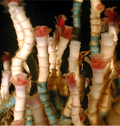Beggiatoa is a genus of Gammaproteobacteria belonging to the order Thiotrichales, in the Pseudomonadota phylum. These bacteria form colorless filaments...
40 KB (4,907 words) - 09:05, 10 July 2024
Beggiatoa leptomitoformis is a chemolithoautotrophic bacterium from the genus of Beggiatoa which has been isolated from wastewater from Moscow in Russia...
2 KB (130 words) - 21:16, 24 November 2024
are closely related to Thioploca and Beggiatoa in function, their structures are different. Thioploca and Beggiatoa cells are much smaller and grow tightly...
43 KB (4,887 words) - 14:54, 21 November 2024
Thiotrichales Family: Thiotrichaceae Garrity et al. 2005 Genera Achromatium Beggiatoa Leucothrix Thiobacterium "Candidatus Thiolava" Thiomargarita Thioploca...
1 KB (61 words) - 17:22, 3 May 2022
Thioploca (section Thioploca and Beggiatoa)
trichomes, morphologically similar to the genus Beggiatoa. Thioploca are often mistaken for Beggiatoa, which are close phylogenetic relatives with similar...
33 KB (3,834 words) - 08:02, 9 October 2024
communities; rather, they usually only support simple microbial mats (Beggiatoa sp.). In the upper slope environment, the hard substrates resulting from...
94 KB (10,661 words) - 09:38, 18 November 2024
bacteria led him to describe several bacteria including Bacillus and Beggiatoa. Cohn was also the first to formulate a scheme for the taxonomic classification...
29 KB (2,977 words) - 00:56, 21 November 2024
known form of lithotrophy during his research with Beggiatoa in 1887. He reported that Beggiatoa oxidized hydrogen sulfide (H2S) as an energy source...
15 KB (1,485 words) - 17:04, 24 October 2024
Clostridium, Desulfovibrio, Chlorobium, Chromatium, Rhodomicrobium, and Beggiatoa, as well as many other species of bacteria, cyanobacteria, and algae....
5 KB (609 words) - 16:42, 14 June 2024
typical of the lake. The crater is covered mostly by Thiothrix sp. and Beggiatoa sp. from a depth of 1.5 m to the opening of the springcave. These together...
6 KB (566 words) - 14:39, 16 August 2024
can be found in plant and animal proteins. In the 1880s, while studying Beggiatoa (a bacterium living in a sulfur rich environment), Sergei Winogradsky...
99 KB (11,015 words) - 01:07, 21 November 2024
later were seen as endophytic algae. Some filamentous bacteria (e.g., Beggiatoa) were originally seen as algae. Furthermore, groups like the apicomplexans...
92 KB (10,628 words) - 12:12, 19 November 2024
Gammaporteobacteria class have been detected, and the most important among them are Beggiatoa, Thioploca and Thiomargarita; besides, large amounts of hydrogen sulfide...
37 KB (3,700 words) - 10:18, 21 November 2024
Nomenclature for algae, fungi, and plants. Formerly, some bacteria, like Beggiatoa, were thought to be colorless Cyanobacteria. The currently accepted taxonomy...
180 KB (17,735 words) - 17:20, 13 November 2024
the base are orange bacterial mats of the sulfide-oxidizing bacteria Beggiatoa spp. and empty shells of various clams and snails, which are also common...
10 KB (1,104 words) - 09:53, 17 July 2024
genus of filamentous sulfur-oxidizing bacteria, related to the genera Beggiatoa and Thioploca. They are usually Gram-negative (but can be Gram-variable)...
7 KB (806 words) - 07:42, 19 May 2024
associated with this phenomenon include Sphaerotilus natans, Zoogloea spp., Beggiatoa spp., and Rhodoferax spp. In addition to being a bioindicator of organic...
22 KB (2,210 words) - 12:24, 14 August 2024
but cannot fix carbon dioxide (CO2). Examples: some Thiobacilus, some Beggiatoa, some Nitrobacter spp., Wolinella (with H 2 as reducing equivalent donor)...
47 KB (5,787 words) - 23:12, 28 September 2024
bacterial photoactivated adenylyl cyclase, bPAC, of the soil bacterium Beggiatoa". The Journal of Biological Chemistry. 286 (2): 1181–1188. doi:10.1074/jbc...
108 KB (11,917 words) - 14:05, 15 November 2024
Clostridium, Desulfovibrio, Chlorobium, Chromatium, Rhodomicrobium, and Beggiatoa, as well as many other species of bacteria, cyanobacteria, and algae....
154 KB (17,057 words) - 17:02, 20 October 2024
discovers the first known form of lithotrophy during his research with Beggiatoa. The Petri dish is created by German bacteriologist Julius Richard Petri...
14 KB (1,366 words) - 17:01, 16 June 2024
marine sediments. For example, benthic sulfur bacteria in genera such as Beggiatoa and Thioploca inhabit anoxic sediments on continental shelves and obtain...
20 KB (2,404 words) - 23:19, 5 March 2024
Small but potent PACs were identified in the genome of the bacteria Beggiatoa (bPAC) and Oscillatoria acuminata (OaPAC). While natural bPAC has some...
10 KB (987 words) - 03:51, 29 November 2023
prokaryotic microorganisms (such as those of the sulfide-oxidizing genus Beggiatoa), often arranged in large bacterial mats near cold seeps. In these locations...
80 KB (9,037 words) - 11:43, 27 July 2024
identified in members of the microbial community such as Thiomicrospira, Beggiatoa, zetaproteobacterium, and gammaproteobacterial endosymbionts of tubeworms...
48 KB (5,270 words) - 21:52, 22 September 2024
marine microorganisms, including Thiomicrospira, Halothiobacillus, and Beggiatoa, are capable of oxidizing sulfur compounds, including elemental sulfur...
24 KB (4,388 words) - 04:22, 20 November 2024
violaceum Warming 1875 Bacterium okenii (Ehrenberg 1838) Trevisan 1879 Beggiatoa roseopersicina Zopf 1883 Rhabdochromatium roseum (Cohn 1875) Winogradsky...
2 KB (99 words) - 21:00, 11 March 2022
SO2– 4 + 2 H+ In modern oceans, Thiomicrospira, Halothiobacillus, and Beggiatoa are primary sulfur oxidizing bacteria, and form chemosynthetic symbioses...
61 KB (7,395 words) - 23:39, 3 November 2024
is Phormidium corallyticum. Sulfide-oxidizing bacteria, dominated by Beggiatoa spp., are present in well-developed bands and exhibit visible vertical...
9 KB (1,029 words) - 19:03, 19 February 2023
and then sulfate by sulfur oxidizing bacteria, such as Thiobacillus, Beggiatoa and many others. Under anaerobic conditions, sulfide can be oxidized to...
68 KB (7,620 words) - 21:11, 24 November 2024




















